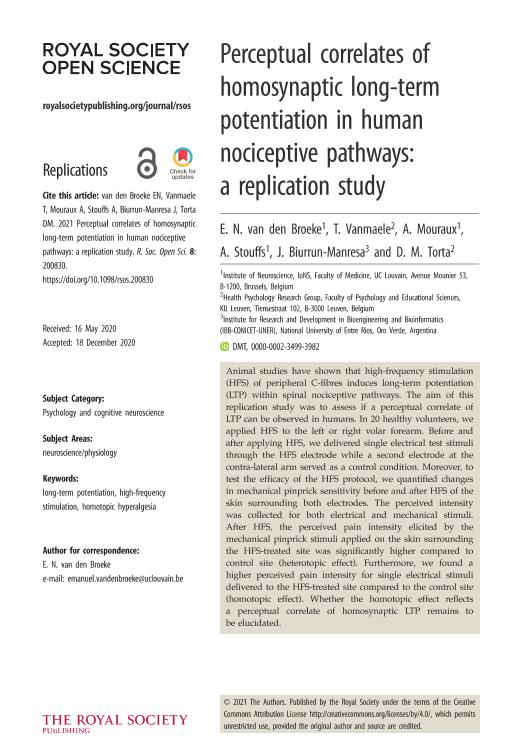Mostrar el registro sencillo del ítem
dc.contributor.author
van de Broeke, Emanuel N.
dc.contributor.author
Vanmaele, Tessa
dc.contributor.author
Mouraux, André
dc.contributor.author
Stouffs, Alexandre
dc.contributor.author
Biurrun Manresa, José Alberto

dc.contributor.author
Torta, Diana M.
dc.date.available
2022-10-17T13:17:42Z
dc.date.issued
2021-01
dc.identifier.citation
van de Broeke, Emanuel N.; Vanmaele, Tessa; Mouraux, André; Stouffs, Alexandre; Biurrun Manresa, José Alberto; et al.; Perceptual correlates of homosynaptic long-term potentiation in human nociceptive pathways: A replication study; Royal Society of Chemistry; Royal Society Open Science; 8; 1; 1-2021; 1-13
dc.identifier.issn
2054-5703
dc.identifier.uri
http://hdl.handle.net/11336/173438
dc.description.abstract
Animal studies have shown that high-frequency stimulation (HFS) of peripheral C-fibres induces long-term potentiation (LTP) within spinal nociceptive pathways. The aim of this replication study was to assess if a perceptual correlate of LTP can be observed in humans. In 20 healthy volunteers, we applied HFS to the left or right volar forearm. Before and after applying HFS, we delivered single electrical test stimuli through the HFS electrode while a second electrode at the contra-lateral arm served as a control condition. Moreover, to test the efficacy of the HFS protocol, we quantified changes in mechanical pinprick sensitivity before and after HFS of the skin surrounding both electrodes. The perceived intensity was collected for both electrical and mechanical stimuli. After HFS, the perceived pain intensity elicited by the mechanical pinprick stimuli applied on the skin surrounding the HFS-treated site was significantly higher compared to control site (heterotopic effect). Furthermore, we found a higher perceived pain intensity for single electrical stimuli delivered to the HFS-treated site compared to the control site (homotopic effect). Whether the homotopic effect reflects a perceptual correlate of homosynaptic LTP remains to be elucidated.
dc.format
application/pdf
dc.language.iso
eng
dc.publisher
Royal Society of Chemistry

dc.rights
info:eu-repo/semantics/openAccess
dc.rights.uri
https://creativecommons.org/licenses/by/2.5/ar/
dc.subject
HIGH-FREQUENCY STIMULATION
dc.subject
HOMOTOPIC HYPERALGESIA
dc.subject
LONG-TERM POTENTIATION
dc.subject.classification
Ingeniería Médica

dc.subject.classification
Ingeniería Médica

dc.subject.classification
INGENIERÍAS Y TECNOLOGÍAS

dc.title
Perceptual correlates of homosynaptic long-term potentiation in human nociceptive pathways: A replication study
dc.type
info:eu-repo/semantics/article
dc.type
info:ar-repo/semantics/artículo
dc.type
info:eu-repo/semantics/publishedVersion
dc.date.updated
2022-09-14T14:12:34Z
dc.journal.volume
8
dc.journal.number
1
dc.journal.pagination
1-13
dc.journal.pais
Reino Unido

dc.journal.ciudad
London
dc.description.fil
Fil: van de Broeke, Emanuel N.. Université Catholique de Louvain; Bélgica
dc.description.fil
Fil: Vanmaele, Tessa. Katholikie Universiteit Leuven; Bélgica
dc.description.fil
Fil: Mouraux, André. Université Catholique de Louvain; Bélgica
dc.description.fil
Fil: Stouffs, Alexandre. Université Catholique de Louvain; Bélgica
dc.description.fil
Fil: Biurrun Manresa, José Alberto. Universidad Nacional de Entre Ríos. Instituto de Investigación y Desarrollo en Bioingeniería y Bioinformática - Consejo Nacional de Investigaciones Científicas y Técnicas. Centro Científico Tecnológico Conicet - Santa Fe. Instituto de Investigación y Desarrollo en Bioingeniería y Bioinformática; Argentina
dc.description.fil
Fil: Torta, Diana M.. Katholikie Universiteit Leuven; Bélgica
dc.journal.title
Royal Society Open Science
dc.relation.alternativeid
info:eu-repo/semantics/altIdentifier/url/https://doi.org/10.1098/rsos.200830
dc.relation.alternativeid
info:eu-repo/semantics/altIdentifier/doi/http://dx.doi.org/10.1098/rsos.200830
Archivos asociados
